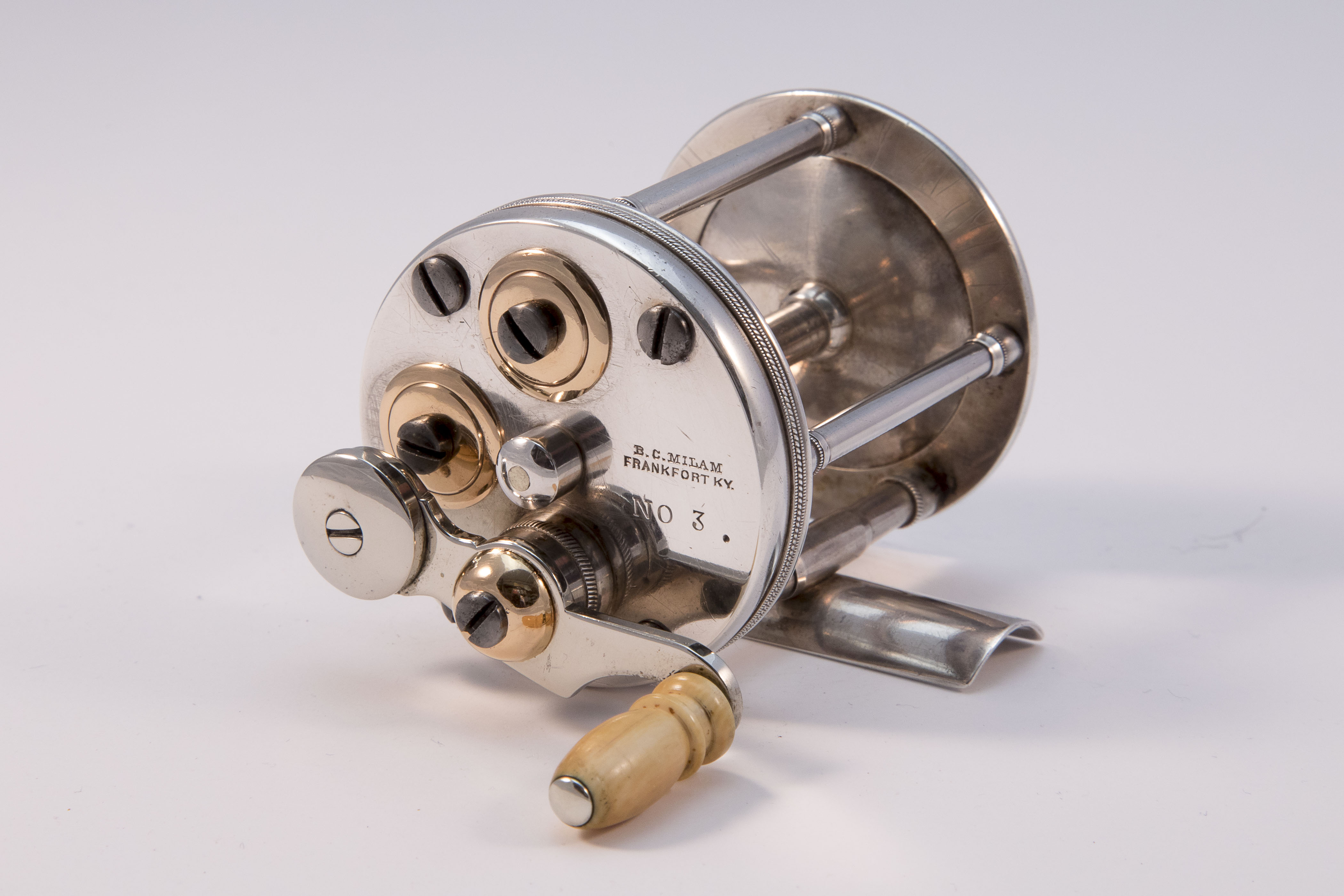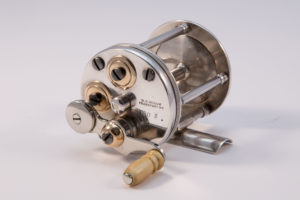
BY Lee McClellan
Many anglers in Kentucky don’t realize our state’s rich contribution to fishing technology and angling history.
Those who use a baitcasting reel to flip a 1/2-ounce black and blue jig to an isolated stump owe a debt of gratitude to Kentucky’s capital city.

Photo by Gene Burch.
“The multiplying reel was refined and perfected in Frankfort, Kentucky,” said John Downs, curator of Capital City Museum in Frankfort. “The reels created by these jewelers were exquisitely crafted pieces. They were highly prized possessions.”
Anyone interested in old reels or fishing history should take a day during the Thanksgiving or Christmas holidays and visit the Capital City Museum at 325 Ann St. in downtown Frankfort. Downs and the Capital City Museum opened an exhibit in early November displaying an array of rare, superbly maintained Frankfort, also called Kentucky, reels.
“We have examples of all four of the major Frankfort reel makers: J.L. Sage, the Meek brothers, Benjamin C. Milam and George Gayle,” Downs explained. “All of them apprenticed with the Meek brothers.”
Jonathan F. Meek opened a jewelry business in the early 1830s in downtown Frankfort. After an apprenticeship in Danville, his brother Benjamin F. Meek joined him in 1835 to make fine jewelry. In 1837, Ben Milam joined the firm and would make his mark in the Kentucky fishing reel industry.
Judge Mason Brown came into the Meek brothers’ shop in the early years of their business to have a fishing reel repaired. He was not satisfied with the performance of his broken reel and insisted the Meek brothers make a new reel for him.
The Meeks traveled to Danville to use the only metal cutting engine in Kentucky at the time to fashion the wheels for the spool. They finished the reel with the same care and precision as the most expensive watch.
Delighted with the results, Judge Brown showed all of his friends his great new fishing reel. Requests for more fishing reels spurred the Meek brothers to order a metal lathe and other tools from Switzerland for reel making. These tools were not available in the United States at that time.
Judge Brown’s request spawned an industry where reels made in Frankfort were known throughout the world for their quality. “These reels were completely handmade,” Brown said. “They could only produce a handful a month.”
They also cost a pretty penny.
“Considering in 1861 a Union soldier made only $13.60 a month, these reels mainly went to those with some means,” Downs said. An 1860 ad for B.C. Milam showed his smallest and lowest-end brass reel cost $13, a month’s pay for a soldier.
Milam eventually took over the fishing reel making and the Meek and Milam reels became known all over the country and Europe for their precision, durability and performance. An early Kentucky history book said that U.S. Presidents Grover Cleveland, William McKinley and Theodore Roosevelt all owned reels made by the firm.
“We have an 1850s era Meek and Milam reel that still spins like new,” Downs said.
The exhibit has the metal lathe on display the Meek brothers ordered from Switzerland to make reels. Milam later acquired the lathe for his reel making and it eventually passed to the Frankfort reel maker George Gayle.
The Frankfort reels borrowed their basic design from reels made by George Snyder, who migrated to Paris, Kentucky, from Bucks County, Pennsylvania, in 1803. He established a watchmaking and silversmith business.
Single action fishing reels in the early 1800s only retrieved line in a 1-to-1 ratio, forcing an angler to reel extremely quick while fighting a fish. The fighting ability of the smallmouth bass in Stoner Creek that flows through Paris influenced Snyder to build the world’s first multiplying reel before 1820. By using multiplying gearing, the spool on Snyder’s early reels spun three times with each turn of the handle. This allowed him to keep up with a hard charging smallmouth bass determined to throw his hook.
Fishing has not been the same since. Later Snyder reels employed a 4.3-to-1 ratio which became almost an industry standard for more than a century. Many saltwater reels still use this ratio today.
Visitors to this incredible exhibit can see the pieces of art these gifted reel makers created in Frankfort.
“The idea for this came about in 2013 when Frankfort hosted the Old Reel Collectors Association’s national convention,” Downs said. “The exhibit is an offshoot of this convention.”
The Capital City Museum is open Monday through Saturday from 10 a.m. to 4 p.m. Admission is free.
Author Lee McClellan is a nationally award-winning associate editor for Kentucky Afield magazine, the official publication of the Kentucky Department of Fish and Wildlife Resources. He is a life-long hunter and angler, with a passion for smallmouth bass fishing.


Be the first to comment